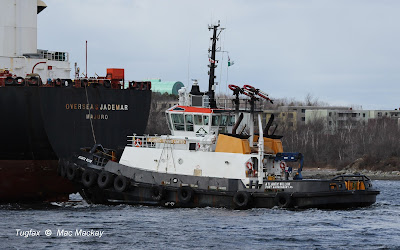Svitzer Canada has struck a knife into the heart of the Quebec towing business by setting up shop in Montreal and going head to head against Groupe Océan in Canada's largest eastern port.
The surprise move occurred March 10 when the powerful 5,000 bhp ice class ASD tugs
Svitzer Nerthus and
Svitzer Njal arrived in their new home port.
Svitzer Nerthus and Svitzer Njal at the usually empty Svitzer dock in Halifax earlier this year.
There are a number of interesting aspects to this move, which I will mention in no particular order.
Since taking over Eastern Canada Towing Ltd Svitzer seemed to lose ground, having lost the Iron Ore Company of Canada contract in Sept-Iles to Océan. (Océan did buy their two old tugs however!)
In a strategic alliance with Atlantic Towing Ltd (a J.D.Irving company), they formed joint venture companies to provide towing services in Halifax and on the Strait of Canso. That saw Svitzer's tugs pull out of Halifax and go to the Strait and Atlantic taking over all tug work in Halifax.
Then there were some disastrous northern towing contracts when
Point Halifax was badly damaged and eventually sold to McKeil and
Svitzer Bedford suffered a serious fire.
However last year signaled a turn around when Svitzer brought in the former Chinese tug
Svitzer Cartier to help out in Port Cartier, QC. (I hear that contract is about to end however)
Svitzer Wombi arrived in Halifax March 30, 2015, where it was renamed Svitzer Cartier for service in Port-Cartier.
Also Svitzer won a contract to service the Baffinland Iron Mine project and brought in
Svtizer Nerthus and
Svitzer Njal from the parent company in Denmark. Both tugs were built in Canada however and passed to Svitzer through other Danish owners.
The Baffinland work was originally awarded to Océan, and on the strength of it they started work on two 8,000 bhp super ice class tugs at their own yard. By the time
Océan Tundra. was delivered Baffinland was restructured and became a seasonal operation in 2015 and Svitzer got the work. Construction of the sister
Océan Taiga was slowed down as there was no apparent work for it. It will be completed in 2016.
The powerful Océan Tundra was built for year-round service in Baffin Island. When that work fell through it has been used for tanker escort on the St.Lawrence, but has been underutilized.
If Svitzers two tugs, acquired for Baffinland, are now based in Montreal, will they abandon the port from July to October or does Svitzer have another plan? Or perhaps Baffinland has slowed down again. Maybe acquiring
Océan Taiga and
Océan Tundra from Océan would be a good idea, but I doubt they would get any break on price! Certainly reassigning the V-S tug
Svitzer Cartier to Montreal does not seem like a good fit.
Svitzer worldwide, like one of its component companies, the former Cory Towage of Liverpool, NS, have long favoured terminal contracts, where they get a long term commitment to provide dedicated tug service to an oil terminal or a particular port. Competing head to head for work has never been to their liking.
Svitzer is part of the giant AP Moller Maersk company, but with only one Maersk ship a week in Montreal, there is hardly enough ''family work'' to support two tugs.
Increased tanker traffic on Montreal, some of which may require escort tugs, might be enough to justify the move if Svitzer has contracts in hand with specific companies.
Svitzer is a deep pocket company that is far more aggressive in the rest of the world than it has appeared to be in Canada. Their world wide fleet consists of 430 vessels (which includes some pilot boats and line boats, but is mostly tugs.) is continually growing as they find work in all corners of the globe and grow their fleet. Perhaps they have bigger plans for Canada than we can imagine.
For example there are still two more Canadian built tugs in Svitzer's European fleet. Both 5,000 bhp ice class ASDs,
Svitzer Nabi (built as
Stevns Breaker) and
Svitzer Nari (ex
Stevns Battler) might be available to Svitzer Canada if there was work here.
Once unthinkable mergers and new ventures among tug companies world wide, are common these days. Long time rivals have joined forces, for example Smit and Kooren in Europe, to exercise control and eliminate costly competition. Or as did Kooren in Hamburg, they have brought in superior equipment to take work away from the established companies.
McKeil tried to break into Montreal, and even acquired a pair of Dutch V-S tugs in 2008, but the project never got across the starting line and the tugs were sold.
Nicloe M was one of the tugs McKeil bought and reconditioned for use in Montreal. It was never licensed for service in Canada and was sold.
It makes one wonder if tug and towing will go they way of many other industries, where local owner entrepreneurs are swallowed up or overwhelmed by large multi-nationals, with deep pockets, low margins and economies of scale.
.












